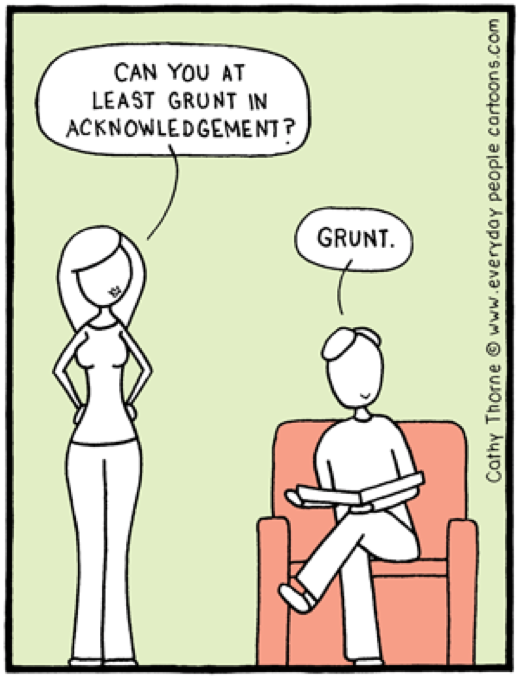Listening is a process and as such it doesn’t unfold in a linear, step-by-step fashion with a defined start and finish. Listening in action is a fast, complex process, with many overlapping components. However, in order to aid in your understanding of listening, we will break the process into five stages and cover each stage in this section: receiving, interpreting, recalling, evaluating, and responding.
 (Image: Pixabay license)
(Image: Pixabay license)
7.2.1: Receiving
Before we can engage other steps in the listening process, we must take in stimuli through our senses. In any given communication encounter, it is likely that we will return to the receiving stage many times as we process incoming feedback and new messages. We primarily take in information needed for listening through auditory and visual channels. Although we don’t often think about visual cues as a part of listening, they influence how we interpret messages. For example, seeing a person’s face when we hear their voice allows us to take in nonverbal cues such as facial expressions and eye contact.
Chapter 3, The Perception Process and Perception of Others, discussed some of the ways in which incoming stimuli are filtered. These perceptual filters also play a role in listening. Some stimuli never make it in, some are filtered into subconsciousness, and others are filtered into various levels of consciousness based on their salience. Salience is the degree to which something attracts our attention in a particular context. We tend to find salient those things that are visually or audibly stimulating and those that meet our needs or interests. Think about how it’s much easier to listen to a lecture on a subject that you find very interesting.
It is important to consider noise as a factor that influences how we receive messages. Some noise interferes primarily with hearing, which is the physical process of receiving stimuli through internal and external components of the ears and eyes, and some interferes with listening, which is the cognitive process of processing the stimuli taken in during hearing. While hearing leads to listening, they are not the same thing. Noise resulting from the physical context, such as other people talking, the sounds of traffic, and music interfere with the physiological aspects of hearing. Noise resulting from the individual context like stress and anger interfere primarily with the cognitive processes of listening.
To improve listening at the receiving stage:
- prepare yourself to listen, both physically and mentally
- concentrate on stimuli most relevant to your listening purpose(s) or goal(s)
- pay attention to turn-taking signals so you can follow the conversational flow
- stay tuned in and avoid interrupting someone while they are speaking
7.2.2: Interpreting
During the interpreting stage of listening, we combine the visual and auditory information we receive and try to make meaning out of that information using schemata. The interpreting stage engages cognitive and relational processing as we take in informational, contextual, and relational cues and try to connect them in meaningful ways to previous experiences. It is through the interpreting stage that we may begin to understand the stimuli we have received. When we understand something, we are able to attach meaning by connecting information to previous experiences. If we have difficulty interpreting information, meaning we don’t have previous experience or information in our existing schemata to make sense of it, then it is difficult to transfer the information into our long-term memory for later recall. In situations where understanding the information we receive isn’t important or isn’t a goal, this stage may be fairly short or even skipped. After all, we can move something to our long-term memory by repetition and then later recall it without ever having understood it.
To improve listening at the interpreting stage:
- identify main points
- avoid assuming and try to see from the speaker’s perspective
- be aware of how context can influence meaning
- pay attention to nonverbal cues, such as facial expression tones, tone of voice, and the use of silence
7.2.3: Recalling
Our ability to recall information is dependent on some of the physiological limits of how memory works. Overall, our memories are known to be fallible. We forget about half of what we hear immediately after hearing it, recall 35 percent after eight hours, and recall 20 percent after a day (Hargie, 2011). Our memory consists of multiple “storage units,” including sensory storage, short-term memory, working memory, and long-term memory (Hargie, 2011).
Our sensory storage is very large in terms of capacity but limited in terms of length of storage. We can hold large amounts of unsorted visual information but only for about a tenth of a second. By comparison, we can hold large amounts of unsorted auditory information for longer—up to four seconds.
As stimuli are organized and interpreted, they make their way to short-term memory where they either expire and are forgotten or are transferred to long-term memory. Short-term memory is a mental storage capability that can retain stimuli for twenty seconds to one minute. Long-term memory is a mental storage capability to which stimuli in short-term memory can be transferred if they are connected to existing schema and in which information can be stored indefinitely (Hargie, 2011). Working memory is a temporarily accessed memory storage space that is activated during times of high cognitive demand. When using working memory, we can temporarily store information and process and use it at the same time.
To improve listening at the recalling stage:
- use multiple sensory channels to decode messages and make more complete memories
- repeat, rephrase, and reorganize information to fit your cognitive preferences
- make connections between what you hear and what you already know
- use mnemonic devices as a gimmick to help with recall
7.2.4: Evaluating
When we evaluate something, we make judgments about its credibility, completeness, and worth. In terms of credibility, we try to determine the degree to which we believe a speaker’s statements are correct and/or true. In terms of completeness, we try to “read between the lines” and evaluate the message in relation to what we know about the topic or situation being discussed. We evaluate the worth of a message by making a value judgment about whether we think the message or idea is good/bad, right/wrong, or desirable/undesirable. All these aspects of evaluating require critical thinking skills, which we aren’t born with but must develop over time through our own personal and intellectual development. One danger within the evaluation stage of listening is to focus your evaluative lenses more on the communicator than the message. This can quickly become a barrier to effective listening if we begin to prejudge a communicator based on their identity or characteristics rather than on the content of their message.
To improve listening at the evaluating stage:
- separate facts, inferences, and opinions
- be familiar with and able to identify persuasive strategies and fallacies of reasoning
- assess the credibility of the speaker and the message
- be aware of your own biases and how your perceptual filters can create barriers to effective listening
7.2.5: Responding
Responding entails sending verbal and nonverbal messages that indicate attentiveness and understanding or a lack thereof. From our earlier discussion of the communication model, you may be able to connect this part of the listening process to feedback. Back-channel cues are the verbal and nonverbal signals we send while someone is talking and can consist of verbal cues like “uh-huh,” “oh,” and “right,” and/or nonverbal cues like direct eye contact, head nods, and leaning forward. Backchannel cues are generally a form of positive feedback that indicates others are actively listening. People also send cues intentionally and unintentionally that indicate they aren’t listening. If another person is looking away, fidgeting, texting, or turned away, we will likely interpret those responses negatively. Paraphrasing, which we will discuss in the Communication Competence section of this chapter, is a responding behavior that can also show that you understand what was communicated.
 (Image: © Cathy Thorne/www.everydaypeoplecartoons.com;printed with permission for use in I.C.A.T.)
(Image: © Cathy Thorne/www.everydaypeoplecartoons.com;printed with permission for use in I.C.A.T.)
To improve listening at the responding stage:
- ask appropriate clarifying and follow-up questions and paraphrase information to check understanding,
- give responses that are relevant
- adapt your response to the communicator and the context
- use back-channel cues to show you are listening